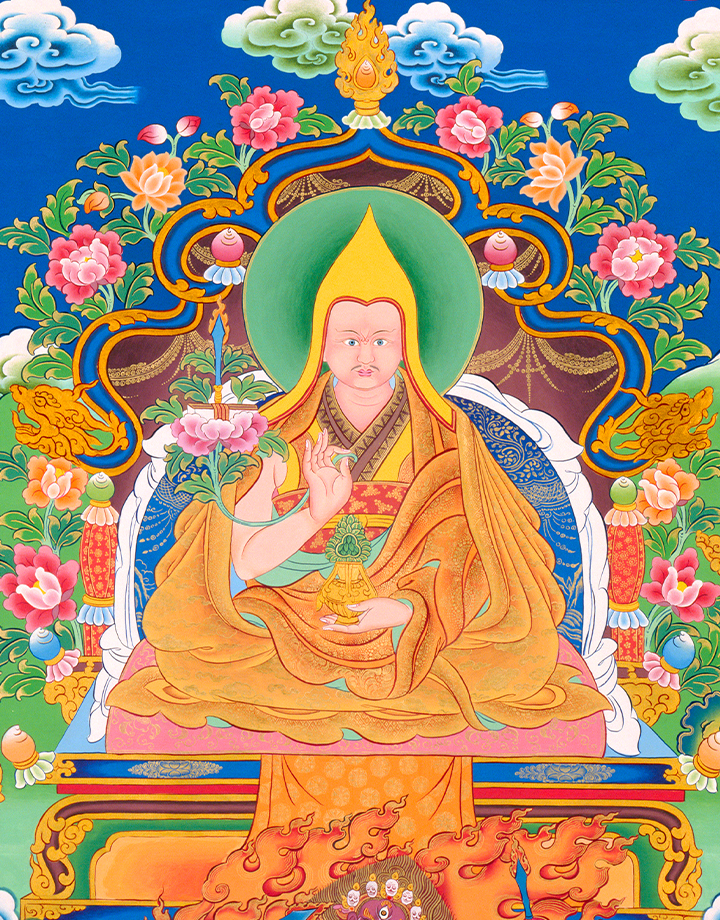Previous Lives
The Protector Saint
Tulku Drakpa Gyaltsen
 When it comes to changing the course of Buddhist history, few masters have had as much of an impact as Tulku Drakpa Gyaltsen. To this day, hundreds of years after his assassination, his name continues to be spoken, uttered with deep reverence and respect.
When it comes to changing the course of Buddhist history, few masters have had as much of an impact as Tulku Drakpa Gyaltsen. To this day, hundreds of years after his assassination, his name continues to be spoken, uttered with deep reverence and respect.
Tulku Drakpa Gyaltsen was very young when he began demonstrating signs of an extraordinary being, such as the ability to recall his past lives, remember his previous teachers and recite prayers from memory. By the time he was two or three years old, he was already speaking and playing with ritual instruments; he was five or six when he began having clear visions of meditational deities (yidams) and enlightened beings.
With such indisputable signs, His Holiness the 4th Panchen Lama recognised Tulku Drakpa Gyaltsen as a reincarnated lama when he was just six years old. The young boy was enthroned as the unmistaken incarnation of Panchen Sonam Drakpa, an exceptional lama who had been the tutor of His Holiness the 3rd Dalai Lama.
Tulku Drakpa Gyaltsen would have a close relationship with the Panchen Lama for his entire life. It is said that once, when Tulku Drakpa Gyaltsen requested for teachings, the Panchen Lama changed his schedule to accommodate his student’s request. At one point, they even entered an isolated retreat together. In this way, the Panchen Lama was able to transmit volumes upon volumes of teachings to his disciple.
From the very beginning, the Panchen Lama personally nurtured and educated his young charge. It was from the Panchen Lama that Tulku Drakpa Gyaltsen received his novice ordination vows, along with a number of initiations including Yamantaka (Vajrabhairava), various long life practices, and the practice of Dharma protectors such as Mahakala and Kalarupa. He also received the transmission of Atisha’s texts on the Path to Enlightenment.
With Tulku Drakpa Gyaltsen’s own imprints and the Panchen Lama’s tutelage, there was no doubt that the young lama would grow to become an accomplished scholar.
He had an unrivalled ability to absorb and understand even the most subtle and profound teachings. By the time he was nine years old, the young boy was already giving teachings and composing commentaries; it was clear to everyone that when Tulku Drakpa Gyaltsen taught, he was speaking from having accomplished the teachings he was giving, and not because he was regurgitating from rote memory.
At age 13, Tulku Drakpa Gyaltsen had already mastered the Lamrim (Stages of the Path to Enlightenment) and seven years later, he became a fully ordained monk. After receiving his vows from the Panchen Lama, it is said that just like his previous incarnations, Tulku Drakpa Gyaltsen effortlessly upheld his monastic vows purely and perfectly, without the slightest transgression.
Thereafter, for the next eight years, Tulku Drakpa Gyaltsen remained under the tutelage of his root guru, requesting for and receiving countless teachings, transmissions and initiations of the highest practices. Before long, word of his academic prowess, humility and deep Dharma practice spread far and wide. Droves of people from all over Tibet, as well as Mongolian and Chinese royalty, came to his residence in Drepung Monastery to pay their respects, seek his blessings and receive teachings.
It was a sight that deeply worried the assistants of His Holiness the 5th Dalai Lama, who also resided in Drepung Monastery and who had just consolidated his political power. Each day, as people walked past the Dalai Lama’s residence, bearing offerings on their way to see Tulku Drakpa Gyaltsen, the assistants’ jealousy compounded. They worried that Tulku Drakpa Gyaltsen’s popularity would eclipse their teacher’s, so they resolved to do something about it.
The 5th Dalai Lama was unaware that any of this was happening. Both the Dalai Lama and Tulku Drakpa Gyaltsen were close students of the Panchen Lama, and they spent a lot of time with one another, studying and debating together. Tulku Drakpa Gyaltsen even received many teachings and initiations from the Dalai Lama and on several occasions, served the Dalai Lama directly. It is recorded that he even personally received or escorted the Dalai Lama on some of his travels; theirs truly was a mutually respectful and close relationship, with Tulku Drakpa Gyaltsen being the 5th Dalai Lama’s peer and Dharma brother.
This was something the Dalai Lama’s assistants could not bear. Threatened by the prominent lama’s popularity, they felt that his position and visibility endangered the 5th Dalai Lama’s burgeoning political power. So they set out to cement their own teacher’s position by getting rid of someone they inaccurately perceived as competition.
During an audience with Tulku Drakpa Gyaltsen, arranged under the guise of making offerings to him, they tried to stab him. However, where the knife struck his body, an eye arose instead of a stab wound. Next, they attempted to poison him but as an accomplished tantric practitioner, Tulku Drakpa Gyaltsen’s body simply expelled the poison. Finally, they tried to strangle him and this time, they were successful.
As he was being killed, this lama who had accomplished ultimate control over his death and rebirth, immediately entered meditation and generated the mind of enlightenment. Tulku Drakpa Gyaltsen thought of Lama Tsongkhapa’s lineage, and prayed that he would always be able to absorb its obstacles and bear the responsibility of assisting, protecting and nurturing its practitioners.
The lama who had spent his life studying, meditating, practising guru devotion and cultivating his practice, then generated the wish to safeguard the lineage and its practitioners, and thus entered clear light with this supreme aspiration in mind.
In life and in death, Tulku Drakpa Gyaltsen’s only thought was the welfare of all sentient beings and the protection of the lineage. His life and legacy bears testament to the power of the enlightened mind that cannot be dampened, misdirected or distracted by worldly endeavours such as power and politics, and will never be deterred by mundane afflictions such as envy and jealousy. And even when a death is premature, a true bodhisattva will still find a way to return to continue benefiting sentient beings, as a meditator, scholar, teacher or even an emperor. Such is the power of the enlightened mind that transcends space, time, projections, conventions and physical form.
